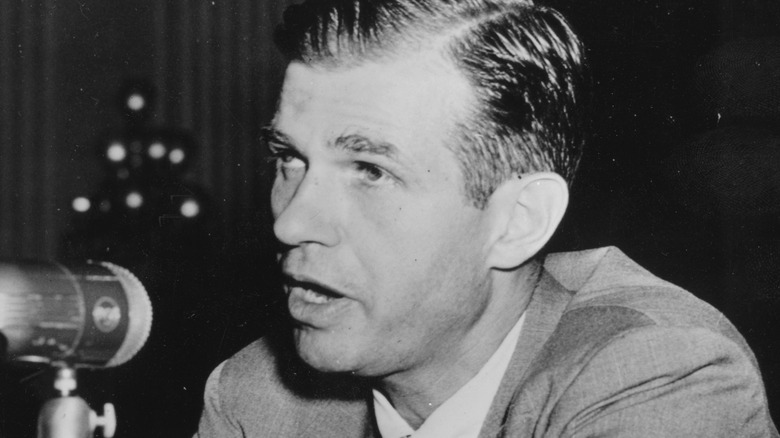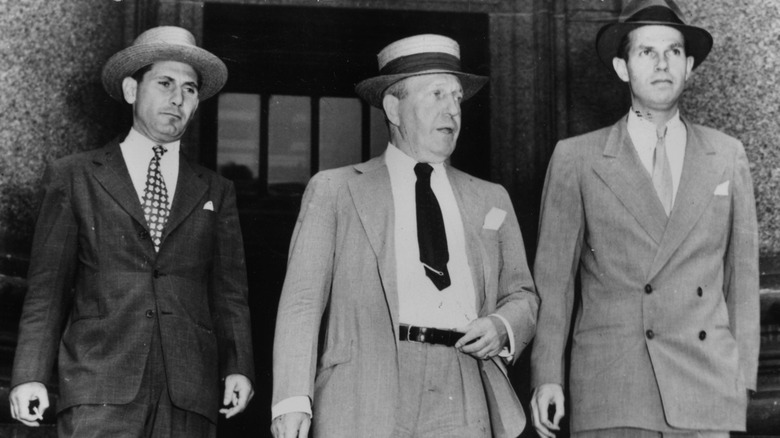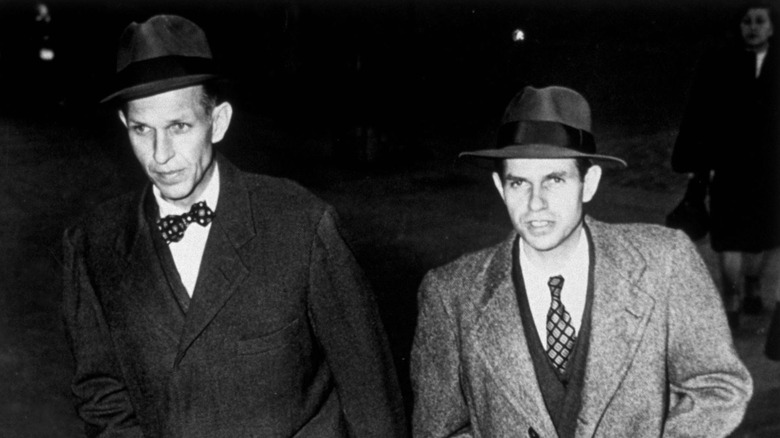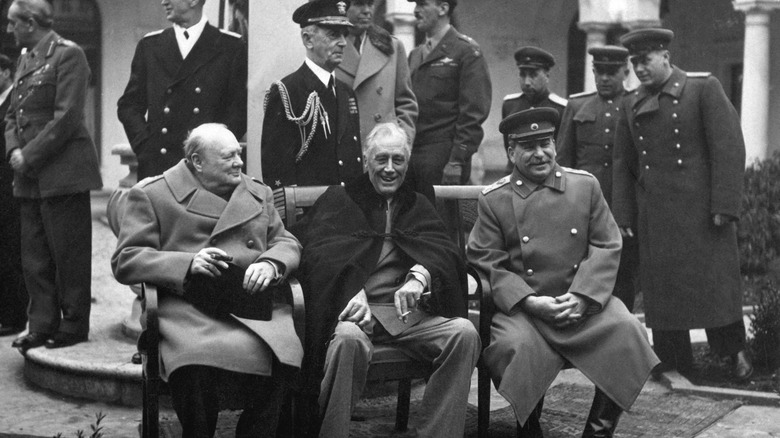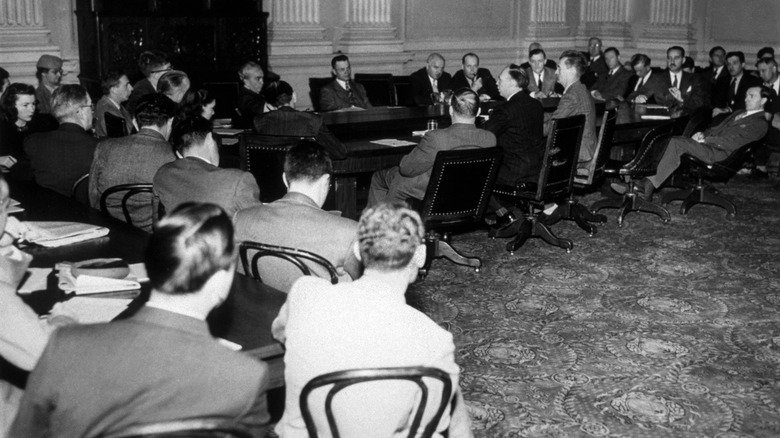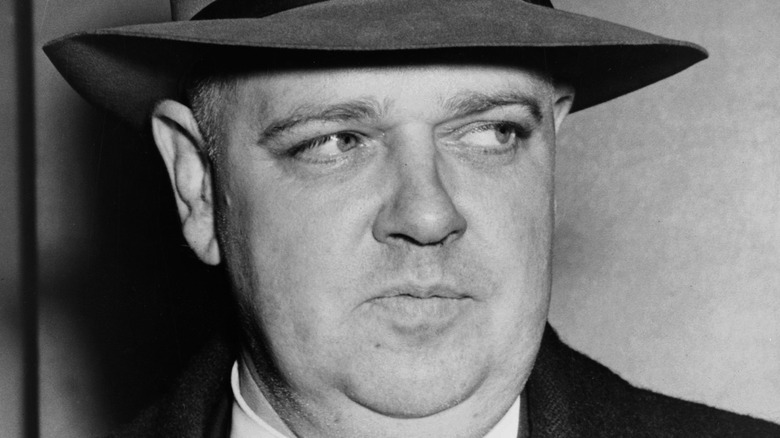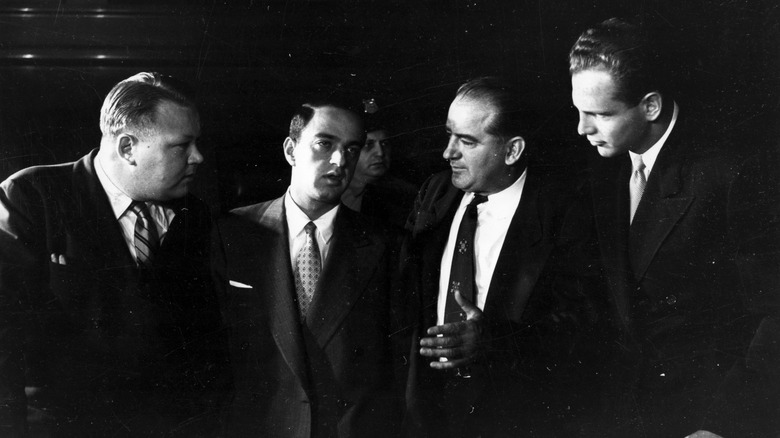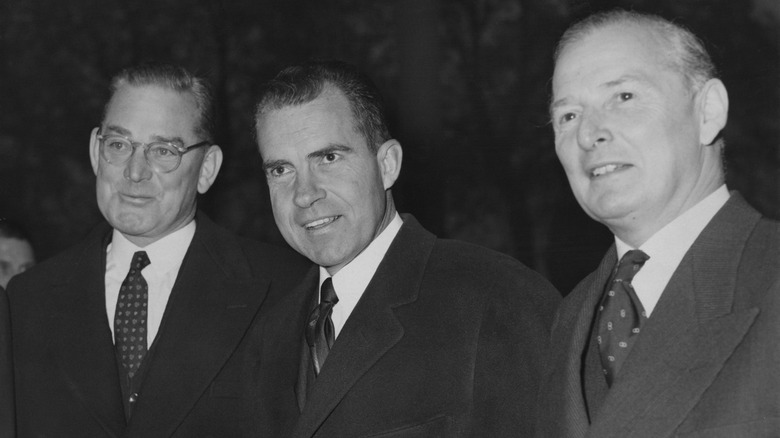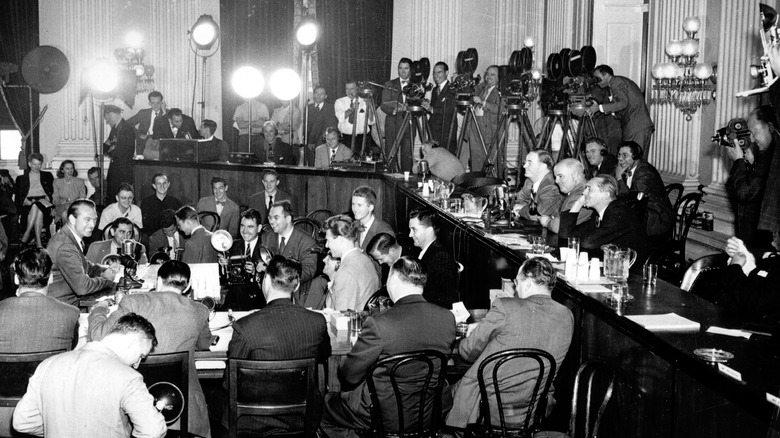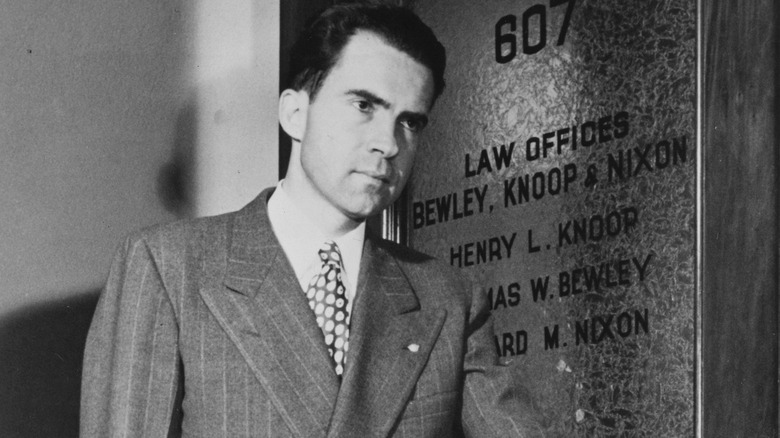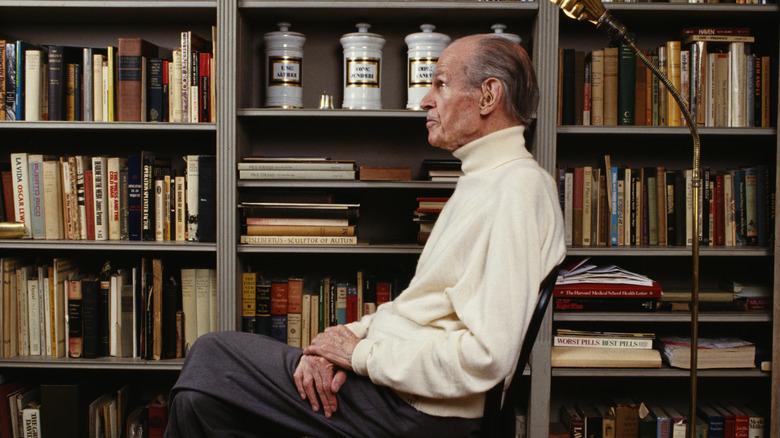The Crazy True Story Of Accused Spy Alger Hiss
The end of World War II pole-vaulted the United States to a prominent role on the world stage, according to the National WWII Museum. Assuming the position of a superpower for the first time in history, America found itself with few rivals apart from the Soviet Union. Although both nations acted as allies by the war's end, their relationship proved troubled. With the close of conflict and no common threats to unite them, it was only a matter of time before these dual world powers would have at it. Their simmering Cold War shaped geopolitics throughout the remainder of the 20th century, according to PBS.
After all, these nations represented polar opposites politically, socially, militarily, economically, and religiously. What's more, the Allied powers couldn't forget about Joseph Stalin and Adolf Hitler's pre-war nonaggression pact. According to the JFK Library, these "two superpowers continually antagonized each other through political maneuvering, military coalitions, espionage, propaganda, arms buildups, economic aid, and proxy wars between other nations."
For these reasons and so many more, a political and ideological showdown proved inevitable. In the wake of extreme tension, a new era of espionage and warfare was born (via History). As global annihilation became a clear and present danger, one name proved synonymous with treason: Alger Hiss. How did Hiss get ensnared by claims of espionage, and was he ever proven guilty? Here's what you need to know about this public servant turned public enemy number one.
Alger Hiss was splashed across the front pages of newspapers
If you lived at the end of the 1940s, the name "Alger Hiss" would've been a daily refrain (via History). A former member of President Franklin Delano Roosevelt's administration, his face was splashed across the front pages of newspapers as a Soviet spy once deeply embedded in the Federal government. How did people around the nation react to the charges against Hiss? It depended on who you asked.
Some, such as Secretary of State Dean Acheson, saw a nefarious motivation behind the charges against Hiss. According to History, "Acheson declared that President Truman's opponents were making a sacrificial lamb out of Hiss. Truman himself declared that HUAC was using 'red herrings' to defame Hiss." But others saw things very differently. They accused Acheson and Truman of "playing nice" with communists. And they asserted that Hiss represented just one individual involved in a more extensive communist infiltration of the nation. Which of these two viewpoints proved true? That's a question researchers and historians still debate today.
Politics further muddied the waters of the scandal. Per the FBI, "Details leaked to the press, and the investigation became national news and embroiled in partisan politics in the run up to the 1948 presidential election." Due to the statute of limitations, Hiss would never get convicted on espionage charges. What's more, he would become a rallying point for those loyal to President Franklin Delano Roosevelt's New Deal. Nevertheless, recently declassified documents clearly incriminate Hiss, according to PBS.
A brilliant law student with a bright future shattered
Alger Hiss' early career prepared no one for his later entanglement with Cold War espionage. Born in Baltimore, Hiss received his education at John Hopkins University and Harvard Law School, per PBS. After clerking for Supreme Court Justice Oliver Wendall Holmes, President Roosevelt's administration hired Hiss on. The handsome, well-educated, and dapper young man appeared to lead the American Dream, which made accusations of espionage all the more unthinkable.
Working for the Federal government, Hiss served as a lawyer in the Department of Agriculture, the Department of Justice, and the Department of State (via Britannica). Few individuals had greater access to top-secret information and the inner workings of the United States' executive and judicial branches than Hiss. So, the mere whisper of his collaboration with the Soviets, particularly as the Second Red Scare heated up, terrified the nation. No wonder rumors of this veritable "spygate" caused such a national scandal.
Nevertheless, Hiss maintained his innocence as the FBI launched an investigation of his activities. They focused on the 1930s and his service to the Roosevelt administration. But as Teaching American History points out, "While the fights over Hiss were underway in the late 1940s and 1950s, the strongest evidence of his guilt remained classified, out of fear that revealing the evidence would expose U.S. signals intelligence capabilities to the Soviets." Of course, the lack of evidence presentable to the public created great difficulty when it came to prosecuting Hiss in the court of public opinion.
Alger Hiss went from exemplary public servant to public enemy
The notion that Alger Hiss might be implicated in espionage for the Soviet Union also proved very problematic for the Feds and, more particularly, "a bludgeon against the Roosevelt and Truman administrations, which had not acted quickly against Hiss" (via Teaching American History). After all, how could a spy working for the USSR end up embedded at such a high level within the American government? And how had he slipped under the radar undetected for so many years?
But the accusations against Hiss also had international implications. After all, Hiss was present at the Yalta Conference, a clandestine gathering of the Allied powers' top leaders in February 1945. While Hiss attended this event, anything he did to tip off the Soviets probably paled in comparison to other means utilized by the Soviets to surveil the U.S. and Great Britain. Strategies included heavily bugged chambers where the British and American delegations debriefed and discussed strategy.
Hiss also represented the United States at the Potsdam Conference and operated as a key State Department official during the United Nations' formative stages. According to History, officials adopted and signed the United Nations Charter on June 26, 1945, and it would officially go into effect on October 24, 1945. In other words, Hiss wielded an incredible amount of power and influence both on the national and international levels, which meant a potentially catastrophic leak of vital information to America's new and dangerous enemy.
The allegations against Alger Hiss
By 1948, Alger Hiss worked as the president of the Carnegie Endowment for International Peace, per History. According to Teaching American History, he maneuvered into this position with the assistance of none other than Dean Acheson. But the controversy swirling around Hiss didn't go away with a change of career. Whitaker Chambers led mounting allegations against Hiss, presenting his testimony to Secretary of State Adolf Berle (via PBS). He told the House Un-American Activities Committee (HUAC) that Hiss had passed state secrets to him for a Soviet official. Elizabeth Bentley, an admitted agent of the USSR, corroborated Chamber's allegations.
"The FBI immediately began probing her claims to ensure those who were credibly named — including Hiss — did not continue to have access to government secrets or power" (via FBI). Elizabeth Bentley's accusations were just one small part of the allegations Alger Hiss faced.
What did the rumors about Hiss entail? Teaching American History reports that "as the wartime alliance between the United States and the Soviet Union increasingly broke down, and the FBI became aware of an extensive Soviet espionage network in the United States, the authorities took Chambers' allegations more seriously." Soon, other sources reported the same thing, including French intelligence sources and a Soviet defector named Igor Gouzenko.
Alger Hiss responds with a slander lawsuit
How did Alger Hiss respond to these allegations? Hiss denied Whittaker Chambers' allegations with vigor, and he refused even to acknowledge knowing Chambers, according to PBS. What's more, he filed a civil suit against Chambers for slander, as reported by the Maryland Law Review.
In the wake of Hiss' slander lawsuit, evidence continued to pile up. It included typewritten and handwritten documents containing State Department content. Besides these documents, a Woodstock typewriter would also get entered into evidence. How did Hiss refute these materials? As reported by PBS, "Hiss and experts on his side argued that the typewriter had been tampered with to produce the desired evidentiary results." While this most definitely reeked of a "conspiracy theory," many in the public preferred it to the notion that the American government might be infiltrated and compromised at the highest levels.
But Chambers would fail to produce this essential evidence in the beginning. Preserved on undeveloped rolls of 35 mm film, these documents would come back to haunt Hiss soon. According to the FBI, "Chambers, who had renounced the Communist Party in the late 1930s, testified reluctantly ... He ultimately acknowledged he was part of the communist underground in the 1930s and that Hiss and others had been members of the group." Despite Hiss' initial angry protestations against Chambers, he would later admit that, indeed, he did know Chambers, per History.
Weighing the domestic influence of communism on America
When accusations of espionage first sullied Alger Hiss' reputation, it came at a time of growing concern over domestic influences from communism. As argued by Teaching American History, "The longevity of the Hiss case is attributable to the fact that it occurred against the backdrop of the Red Scare that was rapidly engulfing the United States."
Some also saw it as verification of Senator Joseph McCarthy's claims that communism had infiltrated the United States government, according to Britannica. After all, if an individual as well-educated and well-positioned as Alger Hiss could "hack" into the system, there was no telling how many other agents had as well, at various levels of rankings of the State Department. But the controversy over the highest-ranking spy in the nation became a politicized issue.
Per David Remnick on History Net, "The case was the Rashomon drama of the Cold War. One's interpretation of the evidence and characters involved became a litmus test of one's politics, character, and loyalties. Sympathy with either Hiss or Chambers was more an article of faith than a determination of fact." In other words, Hiss transformed into a symbol of the now-defunct policies of FDR's "New Deal," while those who opposed him came across as supporters of President Harry Truman. This oversimplification of the situation along America's deeply entrenched political lines proved possible because so much of the evidence against Hiss remained undisclosed.
Some claimed Alger Hiss faced a political witch hunt
Besides suggesting veracity for Senator Joseph McCarthy's domestic communist infiltration claims, the Alger Hiss affair also provided Richard Nixon an opportunity to enter the fray and make a name for himself (via Britannica). Nixon worked as a member of the U.S. House of Representatives and hailed from the "Golden State" of California. He played a prominent role in the investigation that resulted in Hiss's indictment.
For the first time, the indictment brought to the fore the realization that America had a communist spy problem. Yet, despite the obvious implications that Hiss was involved in espionage, President Truman disapproved of the sensationalism of the case. Truman also detested how Hiss's political opponents used the case against him. As a result, Truman acted in a way that appeared contradictory. On the one hand, he reacted with disgust while flipping through the documents that incriminated Hiss. But on the other hand, he still saw the political mob forming against Hiss as a "red herring."
When later asked to explain how he could hold two such contradictory viewpoints simultaneously, he replied, "Of course Hiss is guilty. But that damn Committee isn't interested in that. All it cares about is politics, and as long as they try to make politics out of this Communist issue, I am going to label their activities for what they are — a 'red herring'" (excerpted from Richard Nixon's "Six Crises" via Law 2).
Chambers and Hiss meet face-to-face
Sentiment like this from President Truman made the committee investigating Hiss consider giving up. But that's where Richard Nixon came back into play, holding the HUAC's feet to the fire so the investigation would continue. Besides the documents that would emerge about Alger Hiss, Richard Nixon also teased out an interesting detail from Whittaker Chambers' testimony that lent more credence to his claims. According to The Alger Hiss Story, Chambers had long alleged that the person he met with posed as a freelance writer and went by George Crosley.
Nixon realized a face-to-face meeting needed to happen so Chambers could identify Hiss. And it needed to take place sooner than later. Why? Because Whittaker Chambers and Alger Hiss came from two completely different walks of life. Chambers appeared a bit unkempt, fat, shifty, and awkward. As a former self-avowed Communist, he did little to earn the support of the public. As for Alger Hiss? The debonair man could charm the stripes off a tiger and had already won in the court of public opinion where optics meant everything.
On August 17, 1948, Nixon arranged the meeting between the two men and the HUAC at New York's Commodore Hotel, per Law 2. As soon as Chambers met Hiss, he testified that the man had posed as George Crosley. The dropping bombshells didn't stop there.
Richard Nixon testified at Alger Hiss' trial
Whittaker Chambers also knew about Alger Hiss' hobbies, which included ornithology or the study of birds. Chambers could not have known about this without a close relationship with Hiss per the Nixon Foundation. "Hiss left that Caucus Room that day deterred and degraded as the Committee proved an automobile he had sold in 1936 went through the hands of an intermediary and straight to a man with a record of being a Communist organizer. It corroborated Chamber's detailed testimony precisely."
Not only did Nixon investigate Hiss, but he even testified at his trial. Yet, despite the continued growth of evidence appearing to prove Hiss' guilt, newspapers such as the Washington Post would attribute a guilty verdict in Hiss' perjury trial to Nixon's "oratory skills." What's more, the documents that proved most damning to Hiss earned the moniker "the Pumpkin Papers." Why? Because the 35 mm film strips got stored in a hollowed-out pumpkin at Chambers' house. This terminology sounded absurd, and those with a predilection to side with Hiss played this up.
During the proceedings, Hiss faced accusations of lying about passing these papers to Chambers. After uncovering the "Pumpkin Papers," the Justice Department had all they needed to prosecute Alger Hiss, according to the FBI. Unfortunately, the statute of limitations had already run out regarding the espionage charges. It looked like Hiss might get off scot-free.
The Venona decrypts
That's when prosecutors got creative, bringing Alger Hiss up on perjury charges. Hiss would be convicted and sentenced to two years in prison. Nevertheless, Hiss denied the charges throughout his life. Yet, evidence would eventually emerge too compelling to deny. In 1996, a collection of Venona decrypts got declassified, per Law 2. These documents clearly incriminate Hiss. How did these documents come about? As early as 1943, the forerunner of the National Security Agency (NSA), the U.S. Army's Signal Intelligence Service, started a project codenamed "Venona."
According to Teaching American History, "The project began by studying Soviet diplomatic traffic that had been intercepted but unencrypted dating back to 1939, and grew to include ongoing Soviet messages. In one March 1945 message, a Soviet spy discussed a meeting with an agent codenamed ALES." The message describes Ales' activities, travels, and interactions. According to the message, Ales acted as a Soviet agent who worked in the State Department.
He flew to Moscow and also traveled with President Roosevelt to the Yalta Conference in 1945. Ales also met with the Commissioner for Foreign Affairs, Andrey Vyshinsky. Only one man's travel schedule lined up with these events. And only one man had this level of access to the State Department. You guessed it, Alger Hiss. How definitive are these communications in terms of proof? According to PBS, "Analysts at the National Security Agency have gone on record asserting that Ales could only have been Alger Hiss."
